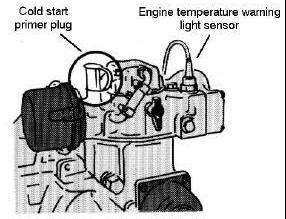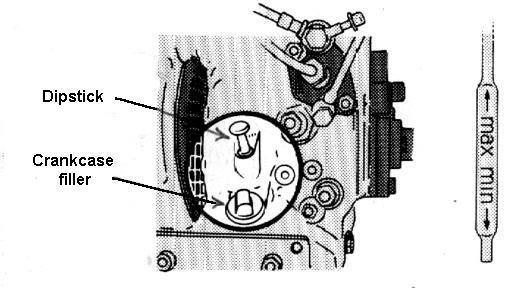
4 minute read
STARTING AND OPERATING
The Decompression Valve
The automatic decompression valve makes starting easier, particularly manual starting. The valve is operated by a twist grip. In the “O” position the valve is closed, while in the “1” sector it is open, but the automatic control device is not engaged.
Turning the grip further – always clock-wise – will engage the automatic control. When the engine is cranked, the valve will automatically return notch by notch to the “0” position. This takes four full turns of the crank handle and the speed gained thereby should make the engine fire at the first following compression stroke.
Use of the decompression valve is also helpful when the battery is too low for sufficient cranking speed.
NOTE – never use the decompression valve to stop the engine
Situated next to the injection pump (on the starboard side just forward of the dipstick). When starting a cold engine, the knob is pulled out fully and the RPM control (throttle) in cockpit pushed to the “full” position, with the gear disengaged.

Cold Weather Starting Aid
A cold start primer is located on top of the cylinder head. Fill with diesel or lubricating oil with the cover removed and press the cover fully down prior to starting.

Engine Shut-Off Control
Pull the handle and hold it in this position until the engine has completely stopped.
A running-in period of approximately 10 hours when the maximum RPM should not exceed 3000 min-1 will prolong engine and gearbox life. After these 10 hours, the engine should be checked by a BMW Marine Dealer in accordance with the instructions in the service section.
Always check the engine oil level, prior to the first starting of the day.

Air Bleeding
The BMW D7 fuel system incorporates a fully automatic air-bleed device.
Prior to starting up after a long rest period or when the fuel system has been worked on, operate the primer pump some 30 – 50 strokes, which will save the battery and starter. (For location of primer pump see diagrams on pages 13 & 15)
Starting A Cold Engine
ß Check that the gear-shift is in neutral ß Set the throttle at the “full” position ß Turn the starter switch key to the “II” position ans check that the alternator charging control lamp comes on ß Turn the key to the “S” position which will engage the starter motor. When the engine fires evenly, release the starter switch key ß Set the throttle at normal idling
Important– see NOTES on next page.
NOTE
If outside temperature is extremely low, the primer device on top of the cylinder head (see diagram on page 8) sgould be filled with diesel or lubricating oil and the plug fully pressed down to inject the oil into the intake manifold.
NOTE
Since a diesel engine is dependent on a certain compression pressure = heat to ignite the fule, one may have to operate the starter for longer periods than is the case with a gasoline engine. Under no circumstances should the starter be engaged for more than thirty seconds at a time.
A battery too low for sufficient cranking speed will doom the starting from the beginning and the battery will drain very rapidly. In such a case, try the decompression valve, or crank the engine manually.
Starting A Warm Engine
ß Check that the gear-shift is in neutral ß Set the throttle at the “full” position ß Turn the starter switch key to the “II” position ans check that the alternator charging control lamp comes on ß Turn the key to the “S” position which will engage the starter motor. ß Release the key as soon as the engine fires ß Decrease the RPM to normal idling ß Check that the alternator charging control lamp is out and the gear-shift is reengaged
ß Prepare the starting according to the instructions for a cold engine on page 9 ß Insert the crank handle and make sure it is properly engaged ß Turn the decompression valve twist grip almost 180o clockwise ß Hold the crank handle as shown i.e. with fingers and thumb on the same side of the handle thus avoiding spraining the hands should the engine rotate backwards ß Crank the engine as rapidly and vigorously as possible. After four crank handle revolutions, the decompression valve will close and the engine will fire normally ß Remove the crank handle and decrease RPM to normal idling

Aloha Owners Association note – owners of some Aloha 27s advise that due to the close proximity of the bulkhead there may be insufficient clearance to allow insertion of the crank handle for manual starting
Stopping the engine
ß Set the control in neutral and allow the engine a few minutes idling in order to even out any thermal stresses ß Pull the shut-off handle fully until the engine has completely stopped








